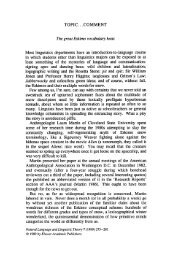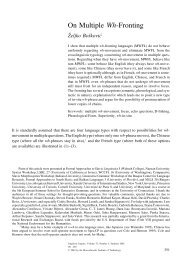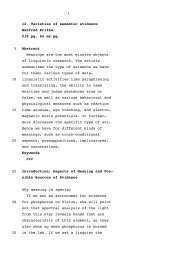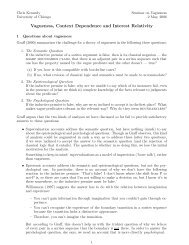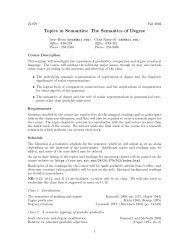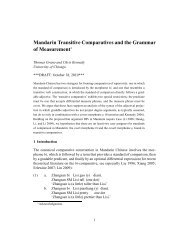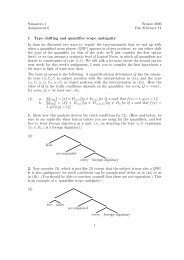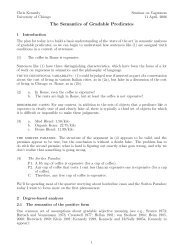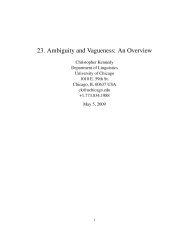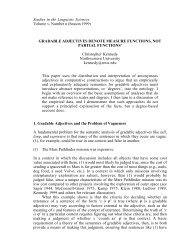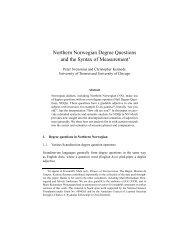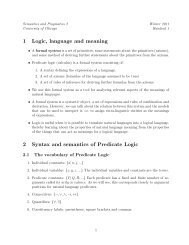On the natural history of negative polarity items - Syntax, Semantics ...
On the natural history of negative polarity items - Syntax, Semantics ...
On the natural history of negative polarity items - Syntax, Semantics ...
Create successful ePaper yourself
Turn your PDF publications into a flip-book with our unique Google optimized e-Paper software.
Denis Paperno<br />
(4) Take an arbitrary man x and take an arbitrary woman y; <strong>the</strong>y kissed each o<strong>the</strong>r.<br />
‘Take an arbitrary x’ is an informal description <strong>of</strong> <strong>the</strong> game <strong>the</strong>oretic semantics for <strong>the</strong><br />
universal quantifier ⇧x. Note that <strong>the</strong> paraphrase translates NP conjunction by sentential<br />
and, and is similar to paraphrases for non-Boolean conjunction in Schein (1993). As <strong>the</strong><br />
paraphrase suggests, <strong>the</strong> quantifier meaning is taken to be an instruction (‘take an x’) ra<strong>the</strong>r<br />
than a function onto truth values (as in generalized quantifier <strong>the</strong>ory).<br />
So my analysis is dynamic, more specifically game-<strong>the</strong>oretic (Hintikka, 1979). In game<strong>the</strong>oretic<br />
semantics (GTS) sentences are interpreted as instructions for evaluating truth <strong>of</strong> a<br />
statement, formalized as games with two players, Verifier and Falsifier. An atomic formula<br />
is a trivial game in which <strong>the</strong> Verifier wins i is true in <strong>the</strong> classical sense. Quantifiers<br />
denote moves in <strong>the</strong> game. ⌃x instructs <strong>the</strong> Verifier to pick a value for <strong>the</strong> variable x, and<br />
⇧x is an instruction for <strong>the</strong> Falsifier to assign a value to x. (Note that ⇧x is a minimal<br />
game, too.) Truth in GTS is a notion secondary to verification procedure but is equivalent<br />
to classical truth in first order logic. A formula is true i it denotes a game in which <strong>the</strong><br />
Verifier has a winning strategy, i.e. Verifier can win no matter how Falsifier plays.<br />
I propose to treat conjunction uniformly as parallel composition, an operation on games<br />
that Abramsky (2007) symbolizes as ||. In <strong>the</strong> game || ⇥, both and ⇥ are played in<br />
parallel, without temporal or causal relation between and ⇥, and <strong>the</strong> Verifier wins i she<br />
wins in both subgames. In addition to parallel composition, Abramsky proposes a sequential<br />
composition operator ·. Note that || ⇥ ⇥ ⇥ || ,but · ⇥ does not equal ⇥ · . I assume<br />
that quantifiers combine with predicates via sequential combination (provably ⇧x · ⇥⇧x ,<br />
⌃x · ⇥⌃x ), and interpret coordination <strong>of</strong> both sentences (it rains and it is cold) and<br />
quantifiers (every man and almost every woman) byparallelcomposition. Forsentential<br />
coordination, parallel composition ( || ⇥) istruth-conditionallyequivalenttostandard<br />
conjunction: both ⇥ and must be true to make || ⇥ true. Boolean predicate conjunction<br />
is analogous to <strong>the</strong> sentential case, given that predicates are interpreted as sentential formulas<br />
with an open variable: [everyone dances and sings] M,g =⇧x.(sing(x) || dance(x)).<br />
Formalizing <strong>the</strong> paraphrase in (4), <strong>the</strong> compositional logical translation <strong>of</strong> (1) is<br />
(5) [Every man and every woman kissed each o<strong>the</strong>r] M,g =[⇧ [MAN] x || ⇧ [WOMAN] y]·kissed(x, y)<br />
(notation for quantifier restriction Q [A] from Peters and Westerst˚ahl (2006, p. 87).<br />
The complex NP every man and every woman is translated as ⇧ [MAN] x || ⇧ [WOMAN] y which<br />
is a combination <strong>of</strong> semantic values for every man (⇧ [MAN] x)andevery woman (⇧ [WOMAN] x).<br />
Parallel composition is designed to be a representation <strong>of</strong> scope independence, so <strong>the</strong><br />
proposal immediately covers examples like (2b) and (3b) which crucially involve quantifier<br />
independence. In (3b), for instance, [almost every woman] M,g can be formalized as a game<br />
where <strong>the</strong> Verifier picks a su⇥ciently big subset WOMAN 0 ⇤WOMAN, and <strong>the</strong> Falsifier<br />
picks an arbitrary x ⌅WOMAN 0 ; since parallel games are independent, <strong>the</strong> set <strong>of</strong> women<br />
involved in kissing doesn’t vary with men.<br />
Parallel combination is a compositional, unified translation <strong>of</strong> and in sentential and<br />
NP conjunction. Originally proposed in <strong>the</strong> game-<strong>the</strong>oretic framework, <strong>the</strong> idea <strong>of</strong> parallel<br />
composition is in principle compatible with o<strong>the</strong>r dynamic <strong>the</strong>ories such as DPL (Groenendijk<br />
and Stokho , 1991). However, combining quantified NPs with || is more <strong>natural</strong> in GTS,<br />
where both universal and existential quantifiers are interpreted dynamically, than in DPL,<br />
where universal quantification is static.<br />
2



